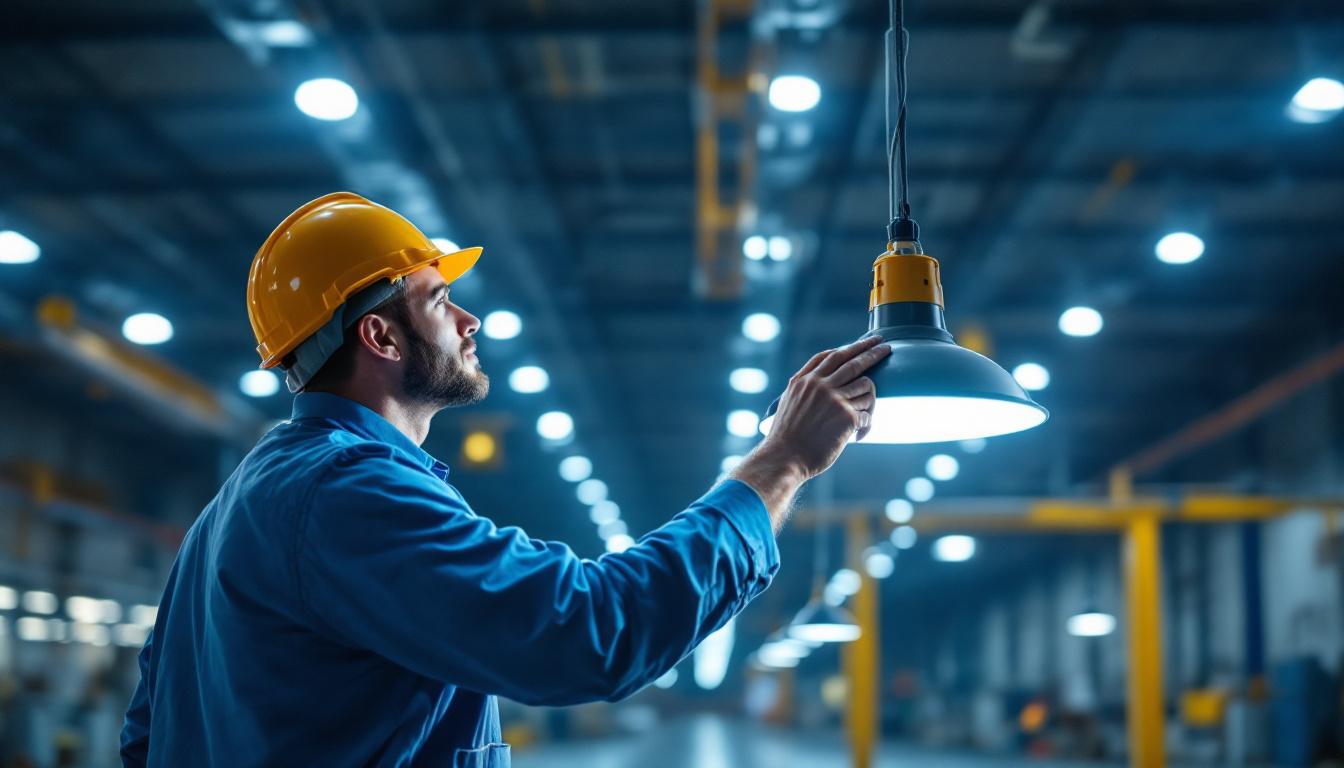
Highbay lighting is a critical component in industrial, commercial, and large-scale retail environments where ceiling heights typically exceed 20 feet. For lighting contractors, mastering the selection, installation, and maintenance of highbay lights is essential to delivering efficient, safe, and cost-effective lighting solutions. This comprehensive checklist covers everything contractors need to know—from initial assessment to final commissioning—to ensure successful highbay lighting projects.
Highbay lights are specialized fixtures designed to illuminate large spaces with high ceilings, such as warehouses, manufacturing plants, gymnasiums, and big-box retail stores. They are engineered to provide uniform, bright lighting over expansive areas, improving visibility and safety while minimizing shadows and glare.
Typically mounted at heights of 20 feet or more, these fixtures come in various types, including LED, metal halide, fluorescent, and induction lamps. Among these, LED highbay lights have become the industry standard due to their energy efficiency, longevity, and superior light quality. The versatility of LED technology allows for various color temperatures, enabling businesses to select lighting that best suits their operational needs and enhances the ambiance of the space. For instance, cooler color temperatures can promote alertness and focus in a manufacturing environment, while warmer tones may be more suitable for retail settings where a welcoming atmosphere is desired.
In addition to their energy-saving capabilities, LED highbay lights also contribute to sustainability efforts. By consuming less power and having a longer lifespan than traditional lighting options, they reduce the frequency of replacements and the associated waste. This aligns with the growing trend of environmentally conscious business practices, making LED highbay lights not just a smart choice for illumination but also a responsible one for the planet.
For lighting contractors, understanding the nuances of highbay lighting is crucial because these installations often involve complex planning, specialized equipment, and adherence to strict safety and energy codes. Properly designed and installed highbay lighting systems can significantly reduce operational costs for clients while enhancing workplace safety and productivity. This is particularly important in environments where tasks require precision and clarity, such as assembly lines or quality control areas, where any lapse in visibility can lead to costly errors or accidents.
Moreover, contractors who excel in highbay lighting projects position themselves as experts in a lucrative market segment, opening doors to long-term maintenance contracts and repeat business. The ability to offer tailored solutions, such as smart lighting controls and integration with building management systems, can further differentiate contractors in a competitive landscape. As more businesses seek to optimize their energy consumption and operational efficiency, contractors who stay ahead of the curve with innovative highbay lighting solutions will find themselves in high demand. Additionally, staying informed about the latest advancements in lighting technology, such as IoT-enabled fixtures that allow for remote monitoring and control, can enhance service offerings and client satisfaction.
Before selecting fixtures or beginning installation, a thorough site evaluation is essential. Contractors should assess ceiling height, room dimensions, existing lighting conditions, and the specific tasks performed in the space. This information informs the lighting design, ensuring adequate illumination levels and uniformity. It is also beneficial to consider the color temperature of the lighting, as warmer tones can create a more inviting atmosphere, while cooler tones may enhance focus and productivity in workspaces.
Consulting industry standards such as those from the Illuminating Engineering Society (IES) helps determine the recommended foot-candle levels for various applications. For example, warehouses typically require 20-50 foot-candles, while manufacturing areas may need 50-100 foot-candles depending on task complexity. Furthermore, it is important to account for the potential impact of natural light sources; large windows or skylights can significantly alter the lighting needs and should be factored into the overall design to prevent over-illumination or glare.
Energy consumption is a primary concern for facility managers, making it a critical factor in fixture selection. LED highbay lights can reduce energy use by up to 50-70% compared to traditional metal halide or fluorescent options, delivering substantial cost savings over time. In addition to energy savings, LED fixtures have a longer lifespan, which reduces the frequency of replacements and the associated labor costs, making them a smart investment for any facility.
Contractors should also evaluate options for integrating lighting controls such as occupancy sensors, daylight harvesting systems, and dimmers. These technologies not only enhance energy efficiency but also contribute to sustainability goals and compliance with green building certifications like LEED. Moreover, smart lighting systems can be programmed to adjust based on occupancy patterns or time of day, further optimizing energy use and creating a more responsive lighting environment that aligns with the needs of the space.
Ensuring compliance with local electrical codes, OSHA regulations, and industry standards is non-negotiable. Contractors must verify that all fixtures and installation methods meet the National Electrical Code (NEC) requirements, especially regarding wiring, grounding, and mounting. Regular training and updates on code changes are essential for contractors to maintain compliance and ensure safety during installation.
Additionally, some jurisdictions may have specific mandates related to energy efficiency or lighting quality. Staying current with these regulations helps avoid costly rework and potential legal issues. It is also wise to engage with local authorities or industry experts during the planning phase to clarify any uncertainties regarding compliance, which can streamline the installation process and foster a collaborative approach to meeting regulatory requirements.
Selecting the appropriate fixture type depends on the application, budget, and client preferences. LED highbay lights are favored for their long lifespan (often exceeding 50,000 hours), low maintenance, and excellent color rendering. They also operate well in cold environments, making them suitable for refrigerated warehouses.
Metal halide fixtures, while less energy-efficient, may still be used in some retrofit projects due to lower upfront costs. However, their shorter lifespan and higher heat output make them less attractive for new installations.
Contractors must balance brightness requirements with energy consumption. Fixture wattage directly impacts energy costs, while lumens measure the amount of light emitted. High-quality LED highbays typically offer 100-200 lumens per watt, enabling contractors to achieve desired illumination levels with fewer fixtures or lower wattage units.
Using lighting design software or consulting photometric data from manufacturers helps optimize fixture placement and wattage to avoid over- or under-lighting.
Beam angle affects how light is distributed across the space. Narrow beam angles (30-60 degrees) concentrate light in specific areas, ideal for task lighting or highlighting aisles. Wider beam angles (90-120 degrees) provide more diffuse, general illumination suitable for open floor plans.
Mounting options include pendant mounts, surface mounts, or hook mounts. The choice depends on ceiling type, height, and accessibility for maintenance. Adjustable mounting brackets can offer flexibility for future layout changes.
Highbay light installation often involves working at significant heights, requiring strict adherence to safety protocols. Contractors should ensure all personnel use appropriate fall protection equipment and follow OSHA guidelines for working on elevated platforms or scaffolding.
Pre-installation checks include verifying power shutdown, confirming fixture compatibility with existing electrical infrastructure, and inspecting mounting surfaces for structural integrity.
Proper wiring is critical for fixture performance and safety. Contractors must use wiring rated for the environment, such as vapor-tight cables in humid or dusty locations. Connections should be secure and protected against moisture and mechanical damage.
Grounding is particularly important to prevent electrical faults. All fixtures and metal mounting components should be properly grounded according to NEC standards.
Installing fixtures according to manufacturer instructions ensures optimal performance and longevity. Contractors should verify that mounting hardware is securely fastened and that fixtures are level and correctly oriented to achieve uniform light distribution.
In some cases, aiming or adjusting fixtures post-installation may be necessary to fine-tune lighting coverage, especially in spaces with complex layouts.
Once installed, contractors should perform a systematic power-up sequence, checking each fixture for proper operation. This includes verifying that lights turn on without flicker or delay and that dimming or control systems function as intended.
Any malfunctioning units should be addressed promptly to avoid future downtime or warranty issues.
Using a light meter, contractors should measure illumination levels at various points to confirm compliance with design specifications and client requirements. Uniformity ratios should also be evaluated to ensure even light distribution without dark spots or glare.
Documenting these measurements provides valuable records for client handover and future maintenance.
Educating clients on the operation and maintenance of their new highbay lighting system enhances satisfaction and reduces service calls. Contractors should provide manuals, warranty information, and guidance on cleaning and replacing components.
Additionally, explaining the benefits of integrated controls and energy-saving features helps clients maximize their investment.
Regular maintenance is essential to preserve lighting quality and fixture lifespan. Contractors should recommend inspection schedules that include checking for dust buildup, fixture alignment, and electrical connections.
Cleaning lenses and reflectors improves light output, especially in dusty or greasy environments common in industrial settings.
Flickering lights, dimming, or complete outages often indicate wiring problems, driver failures, or fixture damage. Contractors should be prepared to diagnose these issues using multimeters and diagnostic tools.
Replacing LED drivers or entire fixtures may be necessary in some cases, but proper troubleshooting can minimize unnecessary replacements.
As technology advances, contractors should advise clients on potential upgrades to improve efficiency or lighting quality. Retrofitting older highbay systems with LED fixtures or adding smart controls can extend system life and reduce energy costs.
Offering retrofit services can create additional revenue streams and foster long-term client relationships.
Highbay lighting projects demand a thorough understanding of technical, safety, and design considerations. By following this comprehensive checklist, lighting contractors can ensure successful installations that meet client expectations for performance, efficiency, and reliability.
Staying informed about the latest technologies, codes, and best practices empowers contractors to deliver superior solutions that enhance workplace environments and contribute to sustainable operations.
Ultimately, expertise in highbay lighting not only drives project success but also strengthens a contractor’s reputation and competitive edge in an evolving industry.
Ready to elevate your highbay lighting projects with the best products on the market? Look no further than LumenWholesale, where we provide contractors with the highest quality, spec-grade lighting solutions at unbeatable wholesale prices. Say goodbye to local distributor markups and hello to a vast selection of reliable, high-performance lighting that meets the strictest industry standards. Plus, with free shipping on bulk orders, you can stock up on premium lighting without worrying about hidden fees or compromises. Don’t miss out on the perfect combination of quality, affordability, and convenience. Visit LumenWholesale now for Wholesale Lighting at the Best Value and start your project with confidence.

Discover the importance of the Seal 4 5000K 120-277V in modern lighting installations.

Discover how greenhouse lighting technology is revolutionizing efficiency for lighting contractors.

Discover how solar powered garden lights can revolutionize your outdoor lighting projects by boosting efficiency and sustainability.

Explore the pros and cons of Dawn Dusk Light compared to other lighting solutions in this insightful guide for contractors.